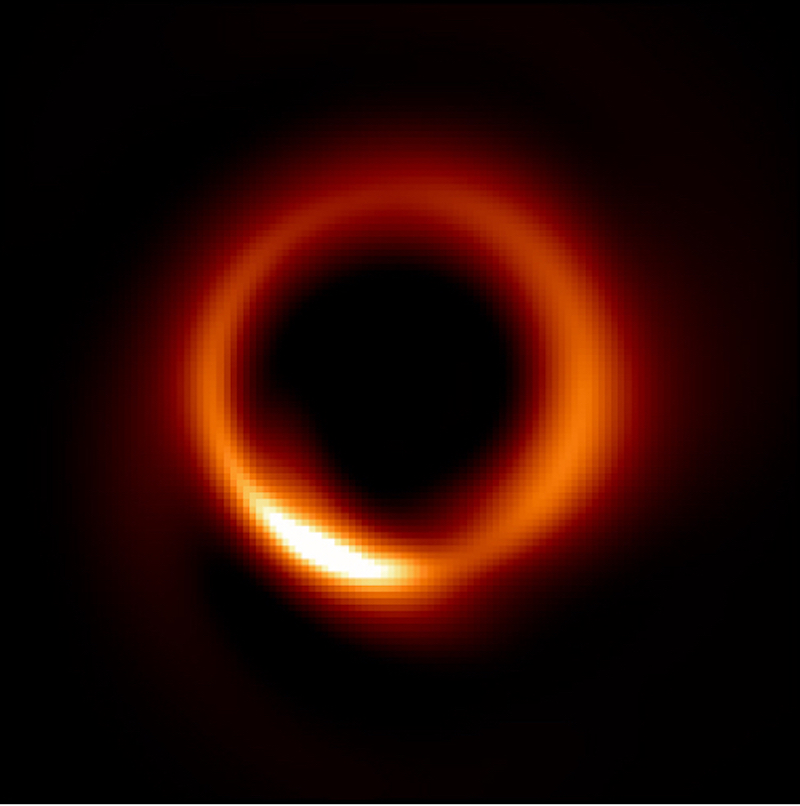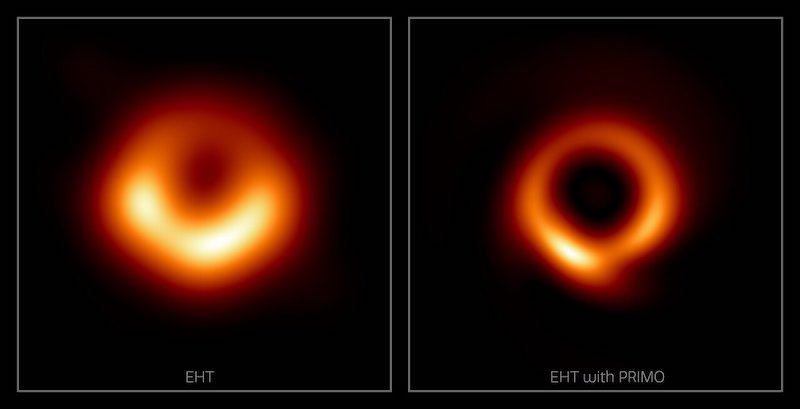
Do you remember in 2019, when astronomers released the first-ever image of a black hole in 2019? The Event Horizon Telescope (EHT) captured it, and the image was an amazing and historic achievement. On April 13, 2023, another team of researchers announced they’ve used machine learning to give the photo a makeover. Now, the image appears sharper than before. By the way, this black hole is of the supermassive variety. It lies in the center of a giant elliptical galaxy called Messier 87, 55 million light-years from Earth.
The researchers published the peer-reviewed details of the image reconstruction in The Astrophysical Journal Letters on April 13, 2023.
1st-ever image of black hole gets a PRIMO makeover
The researchers have developed a new machine-learning technique to enhance the fidelity and sharpness of radio interferometry images. The new machine-learning technique is called principal-component interferometric modeling (PRIMO). In particular, PRIMO uses a kind of machine learning called sparse dictionary learning. Generally speaking, this technique “teaches” computers by using thousands of examples. It uses sparse coding to find gaps in the input data. The input data is in the form of a linear combination of basic elements as well as those basic elements themselves. These elements are called atoms, and together they compose a dictionary.
As an illustration, the Institute for Advanced Study’s press release said:
For example, if a computer is fed a series of different banana images – with sufficient training – it may be able to determine if an unknown image is or is not a banana.
Lead author Lia Medeiros of the Institute for Advanced Study said:
With our new machine learning technique, PRIMO, we were able to achieve the maximum resolution of the current array. Since we cannot study black holes up-close, the detail of an image plays a critical role in our ability to understand its behavior. The width of the ring in the image is now smaller by about a factor of two, which will be a powerful constraint for our theoretical models and tests of gravity.
Using 30,000 simulated images to produce a sharper photo
So, how did this help the researchers improve the image of the black hole? The researchers collected over 30,000 simulated images of gas accreting onto a black hole. Next, PRIMO looked for common patterns among the images. Then, all of the images were combined into one new high-fidelity image. Overall, the new and updated image was able to show details that were not visible in the original image. As Tod Lauer from NOIRLab explained:
PRIMO is a new approach to the difficult task of constructing images from EHT observations. It provides a way to compensate for the missing information about the object being observed, which is required to generate the image that would have been seen using a single gigantic radio telescope the size of the Earth.
The new image is crisper, with the bright ring of gas around the black hole looking more “in focus” and thinner, more like a Cheerio now than a donut. In addition, it is still consistent with the original Event Horizon Telescope data as well as theoretical predictions.
Watch a video below, which explains more about how the newer, sharper image was made:
1st image was astonishing, but lacking detail
The Event Horizon Telescope isn’t just any radio telescope. It’s a collection of seven radio telescopes around the world. They work together to achieve the equivalency of a virtual Earth-sized telescope, powerful enough to distinguish a black hole’s event horizon. The event horizon is a black hole’s outer boundary, where the escape velocity is equal to the speed of light. Therefore, nothing can cross that boundary from within the black hole and escape.
The event horizon of Messier 87’s black hole is enormous indeed, at about 25 billion miles (40 billion km) across.
As amazing as that first image was, however, it still lacked some detail. There were still some gaps in the data. But now, the new PRIMO machine-learning technique can help to fill in those gaps. Medeiros said:
With our new machine-learning technique, PRIMO, we were able to achieve the maximum resolution of the current array. Since we cannot study black holes up close, the detail in an image plays a critical role in our ability to understand its behavior. The width of the ring in the image is now smaller by about a factor of two, which will be a powerful constraint for our theoretical models and tests of gravity.

Even better black hole images in the future
The researchers expect to be able to produce even better images of the black hole in the future. They plan to do this with additional telescope locations and higher available bandwidth for the data. It will be interesting to see what they come up with!
Medeiros said:
The 2019 image was just the beginning. If a picture is worth a thousand words, the data underlying that image have many more stories to tell. PRIMO will continue to be a critical tool in extracting such insights.
New techniques like PRIMO could also have applications beyond black holes, as Medeiros noted:
We are using physics to fill in regions of missing data in a way that has never been done before by using machine learning. This could have important implications for interferometry, which plays a role in fields from exo-planets to medicine.
Bottom line: Do you remember the 1st-ever photo of a black hole released in 2019? Researchers have now produced an even better, sharper version using machine learning.
Source: The Image of the M87 Black Hole Reconstructed with PRIMO











